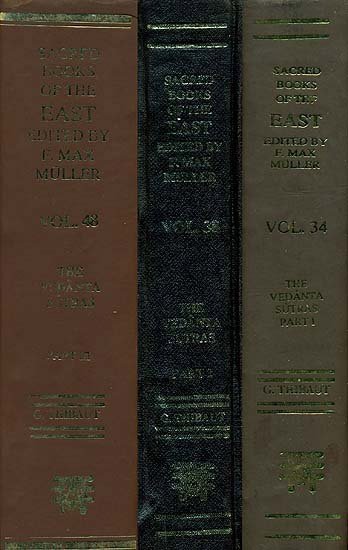Brahma Sutras (Ramanuja)
by George Thibaut | 1904 | 275,953 words | ISBN-10: 8120801350 | ISBN-13: 9788120801356
The English translation of the Brahma Sutras (also, Vedanta Sutras) with commentary by Ramanuja (known as the Sri Bhasya). The Brahmasutra expounds the essential philosophy of the Upanishads which, primarily revolving around the knowledge of Brahman and Atman, represents the foundation of Vedanta. Ramanjua’s interpretation of these sutras from a V...
Sutra 3.2.21
21. For the text denies the previously declared so-muchness; and declares more than that.
It is impossible to understand the text 'not so, not so' as negativing those distinctions of Brahman which had been stated previously. If the text meant that, it would be mere idle talk. For none but a person not in his right mind would first teach that all the things mentioned in the earlier part of the section are distinctive attributes of Brahman—as which they are not known by any other means of proof—and thereupon deliberately negative his own teaching. Although among the things mentioned there are some which, in themselves, are known through other means of proof, yet they are not thus known to be modes of Brahman, and others again are known neither in themselves nor as modes of Brahman. The text therefore cannot merely refer to them as things otherwise known, but gives fundamental instruction about them. Hence the later passage cannot be meant as a sheer negation, but must be taken as denying the previously described 'so-muchness' of Brahman; i.e. the passage denies that limited nature of Brahman which would result from Brahman being viewed as distinguished by the previously stated attributes only. The word so refers to that limited nature, and the phrase not so therefore means that Brahman is not distinguished by the previously stated modes only. This interpretation is further confirmed by the fact that after that negative phrase further qualities of Brahman are declared by the text: 'For there is not anything higher than this not so. Then comes the name, the True of the True; for the prāṇas are the True, and he is the True of them.' That means: Than that Brahman which is expressed by the phrase 'not so' there is no other thing higher, i.e. there is nothing more exalted than Brahman either in essential nature or in qualities. And of that Brahman the name is the 'True of the True.' This name is explained in the next clause, 'for the prāṇas,' etc. The term prāṇas here denotes the individual souls, so called because the prāṇas accompany them. They are the 'True' because they do not, like the elements, undergo changes implying an alteration of their essential nature. And the highest Self is the 'True of the True' because while the souls undergo, in accordance with their karman, contractions and expansions of intelligence, the highest Self which is free from all sin knows of no such alternations. He is therefore more eminently true than they are. As thus the complementary passage declares Brahman to be connected with certain qualities, the clause 'not so, not so' (to which that passage is complementary) cannot deny that Brahman possesses distinctive attributes, but only that Brahman’s nature is confined to the attributes previously stated.—Brahman therefore possesses the twofold characteristics. That the clause 'not so' negatives Brahman’s being fully described by the attributes previously mentioned, was above proved on the ground that since Brahman is not the object of any other means of proof, those previous statements cannot refer to what is already proved, and that the final clause cannot therefore be meant to deny what the previous clauses expressly teach. The next Sūtra now confirms this circumstance of Brahman not lying within the sphere of the other means of proof.
